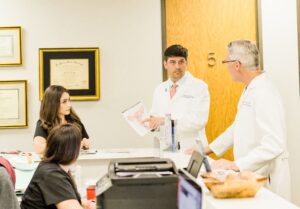Are you wondering, what is adenomyosis? So many women know that they can develop fibroids and endometriosis. They also know that both those conditions can be extremely painful. But what they don’t know is that adenomyosis can be equally painful. And it can be hard to diagnose, even though it affects up to 30% of women around the world. Let’s take a closer look at this uterine condition.

When you have adenomyosis, the tissue that lines your uterus accumulates inside its muscular wall. Adenomyosis is a benign condition (that means it’s not cancer). But you still have to worry about troubling side effects. And the number one offender with this condition? Debilitating pain.
Adenomyosis is pretty common. An estimated 10% of women live with this condition. And women over the age of 40, especially ones who've had uterine surgery or multiple pregnancies, are more at risk. At least, that’s what research suggests. It’s tough to determine the exact prevalence of adenomyosis. That's because there's no standard diagnostic criteria (doctors don’t have a clear set of signs, symptoms, and tests to guide adenomyosis care.) Which is the reason this condition is hard to diagnose. And the reason you need to learn more about adenomyosis.
When you have adenomyosis, you may experience symptoms such as severe cramps, irregular bleeding, chronic pelvic pain, pain in your legs and back, a swollen abdomen, long periods, painful sex and infertility.

Discussing your full reproductive history with your healthcare providers can help you receive a diagnosis of adenomyosis.
But many uterine conditions—including endometriosis and fibroids—present with the same symptoms. In fact, studies show lots of disagreement on the prevalence of this problem. Because literature suggests that anywhere from 20% to 88% of symptomatic women ultimately get diagnosed. But with that broad range, we often confuse this condition for others. Also, many women with adenomyosis also have endometriosis. And this makes it much harder for you to seek appropriate treatment and find relief.
But that’s not the only reason it can be tough to diagnose adenomyosis: you can’t always detect trouble with an ultrasound. Even an MRI might not reveal abnormal tissue in your uterine muscle, especially if you also have fibroids, since they may block the imaging view.
For that reason, if you are dealing with adenomyosis symptoms and you haven’t received an accurate diagnosis, it is important to see an expert who can help.
Sometimes, diagnosing adenomyosis is a process of elimination. But there are many clues to point your doctor in the right direction. First, consider your age: this condition is more common with women in their 30s and 40s. You are also more likely to develop adenomyosis if you’ve delivered a child via cesarean section, or if you have endometriosis and/or fibroids.
Given those connections, it’s important to discuss your complete reproductive history with your health care provider if you’re trying to receive an accurate diagnosis. After taking your medical history, your doctor may need to perform a transvaginal ultrasound and MRI (magnetic resonance imaging) in order to deliver an accurate diagnosis. Also, taking a myometrial biopsy can speed up diagnosis. (That's when your doctor takes a tissue sample from the middle layer of your uterus.)
Once you have a diagnosis, treating your condition is a personal choice. If your symptoms are minimal, you may opt to manage pain with non-prescription drugs like Advil or Motrin. Many women can find relief by increasing their exercise levels, or even by choosing to get fitted for a hormonal IUD (intrauterine device.)
But some women need more permanent treatment. And that is where our Houston fibroid specialists can help. Some women can find relief from adenomyosis with uterine artery embolization (UAE), a minimally invasive procedure that uses a catheter to deliver small particles that block the blood supply to your uterine. To learn more about UAE and your adenomyosis treatment options, schedule a consultation with Dr. Fox or Dr. Hardee today.
Sources: Seminars in Interventional Radiology, Journal of Minimally Invasive Gynecology

Scheduling
Please contact our dedicated specialists to schedule a consultation today.
2024 Houston Fibroids. All rights reserved. Website Design by Healthcare Success